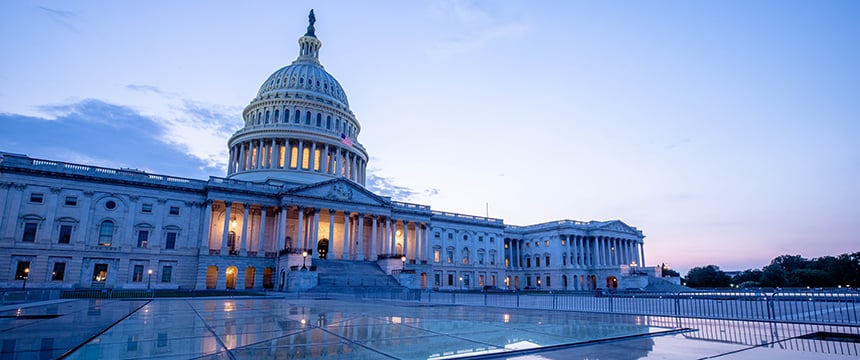President Biden’s Executive Order on Competition Could Mean Broad Changes Across a Range of Industries

On Friday, July 9, 2021, President Biden issued a sweeping Executive Order1 that could have far-reaching implications for businesses across a broad spectrum of industries. The Executive Order takes a government-wide approach and includes 72 initiatives by over a dozen federal agencies, with the stated aim of addressing competition issues across the nation’s economy to protect consumers and workers and bolster innovation.2
Significantly, the Executive Order does not immediately put any specific policies into effect or establish any requirements or prohibitions for businesses or other nongovernmental entities. Rather, the Executive Order directs and encourages federal regulators to consider policy initiatives, conduct a series of reviews, and craft new rules to implement the overarching policy goals of the Administration – a process that could take many months, if not years, to unfold. Nevertheless, the ramifications are likely to be significant for businesses of all types, and some policy initiatives could necessitate changes earlier than others. Legal challenges inevitably will also arise from agency actions taken as a result of the Executive Order.
The Executive Order identifies a number of industry sectors that it says are in need of reform due to what it characterizes as “excessive” corporate consolidation and market abuses. The Executive Order focuses predominantly on labor markets, agricultural markets, Internet platform industries, health care markets (including specifically prescription drugs, health care services, health insurance, and hearing aids), repair markets, and domestic markets directly affected by foreign cartel activity. Notwithstanding its focus on particular market segments, given the Executive Order’s broad scope and directives, if fully implemented it could have extensive implications for numerous other industries.
With its focus on enhanced Federal Trade Commission (FTC) rulemaking and more vigorous enforcement of the antitrust laws, the Executive Order’s initiatives could also materially transform the standards that the FTC and Department of Justice Antitrust Division (DOJ) use in determining whether to bring enforcement actions, particularly in light of the significant momentum around antitrust reform created by recent bills in the House and Senate.
This alert highlights a number of provisions of the Executive Order that are immediately relevant to antitrust policy and enforcement.
- Creation of a White House Competition Council. The Executive Order establishes a new White House Competition Council to coordinate the White House response to anticompetitive behavior. The Council will be chaired by the Assistant to the President for Economic Policy and Director of the National Economic Council. The Council will include representatives from key agencies3 and invites participation by the FTC and other independent agencies. This structure means that direct participants from each agency will be members of the President’s party, which will likely have a significant impact on the Council’s actions. Notably, though coordination across agencies is the Council’s goal, the Executive Order also provides that the Council shall not discuss any current or anticipated enforcement actions. This safeguard is presumably to avoid the White House’s involvement in independent agency law enforcement decisions, including those made by the FTC.
- Focus on New Industries and Technologies. In addition to focusing on traditional industries like health care and agriculture, the Executive Order also states that the Administration’s goal is to use the antitrust laws to address “the challenges posed by new industries and technologies, including the rise of the dominant Internet platforms, especially as they stem from serial mergers, the acquisition of nascent competitors, the aggregation of data, unfair competition in attention markets [markets that hinge on user attention], the surveillance of users, and the presence of network effects.”4 The Executive Order makes clear that the Administration wants to see new guidelines on surveillance and the accumulation of data – practices the Administration is concerned may harm competition, consumer autonomy, and consumer privacy. At the same time, the Order also encourages the restoration of Obama-era net neutrality rules, which require Internet service providers to treat all Internet traffic equally. Moreover, the Executive Order aims to promote competition by small businesses and encourages the FTC to establish rules to address perceived unfair competition in major Internet marketplaces. While the Executive Order focuses on “Big Tech” and Internet service providers, these directives could have broader implications for manufacturers of any technology.
- Merger Enforcement. To address perceived market consolidation across the economy, the Executive Order encourages review and potential revision of the federal horizontal and vertical merger guidelines issued jointly by the DOJ and FTC. In the immediate wake of the Executive Order, the Chair of the FTC and the Acting Assistant Attorney General for Antitrust at the DOJ announced that they will initiate a review of the agencies’ joint merger guidelines, with the goal of updating these guidelines to reflect “a rigorous analytical approach.” The FTC Chair has also announced that the FTC will vote later this month on rescinding a 1995 policy statement in which the FTC loosened prior approval requirements in merger clearance settlements. Also notable is the Executive Order’s reaffirmation of the government’s authority to challenge consummated transactions if they are considered to be in violation of the federal antitrust laws. While historically challenges to consummated transactions have been relatively uncommon, the Executive Order suggests the agencies may break from past practice, which could have significant implications for future merger reviews.
- Non-Competes, No-Poach, and Wage-Fixing Guidance: With respect to labor markets, the Executive Order includes three specific directives in which it encourages: (i) FTC regulations curtailing the unfair use of employee non-compete provisions</a>; (ii) FTC regulations against “unfair occupational licensing restrictions” (e.g., state or federal laws that impede economic mobility); and (iii) FTC and/or DOJ to consider whether to revise past guidance on the sharing of employee wage and benefit information, to prevent collusion among competing employers. For those businesses that routinely use non-compete provisions, it will be critical to monitor the FTC’s rulemaking process on this issue, including potentially participating in the public comment process before any rules are adopted. Businesses should also be prepared to reassess their information exchange policies as it relates to employee wage and benefit information, should the FTC and DOJ issue revised guidance on this issue. To learn more, please see our webinar on this topic.
- Health Care. The Executive Order asserts that hospital mergers have left many areas, particularly rural areas, with inadequate or more expensive health care options and therefore affirms that it is the policy of the Administration to enforce the antitrust laws in this sector. In its summary of the Executive Order, the White House cited a history of “unchecked mergers” in the hospital sector as leading to the ten largest health systems in the United States, controlling one quarter of non-federal hospitals according to third-party analyses. Although the Executive Order does not specifically encourage retrospective reviews or challenges of hospital mergers, the characterization of past mergers as being “unchecked” may lead the FTC in particular to consider ramping up its retrospective reviews of health care provider transactions. The Executive Order further directs Department of Health and Human Services (HHS) to support existing hospital price transparency rules and to finish implementing bipartisan federal legislation to address surprise hospital billing. Lastly, one of the most interesting aspects of the Executive Order is the directive to HHS to consider proposing rules that will permit hearing aids to be sold over the counter. According to the White House summary of the Executive Order, the requirement that patients with hearing loss be evaluated in a doctor’s office to obtain a prescription for hearing aids has discouraged entry by new hearing aid manufacturers and resulted in high levels of concentration, along with high prices. Although improving health care through antitrust enforcement has been a priority for several administrations, the Executive Order demonstrates that health care will continue to be a focus of the Biden Administration. To learn more about the Executive Order, along with changes at the FTC and the health care implications of the recent proposed federal legislation to overhaul antitrust enforcement, please follow Foley’s Health Care Law Today blog.
- Pharmaceuticals. The Executive Order encourages the FTC to ban “pay for delay” patent settlement agreements and similar agreements by rule. At the same time, it also directs the HHS to coordinate with other federal officials to ensure the patent system does not unjustifiably delay generic and biosimilar competition. In addition, the Executive Order directs HHS, with the Chair of the FTC, to identify and address efforts that impede generic and biosimilar competition, including deceptive statements about the safety or efficacy of generic drugs or biosimilars. Moreover, HHS is to issue a comprehensive plan within 45 days of the Order to combat high prescription drug prices and price gouging. While the FTC’s scrutiny of competition within the pharmaceutical industry is nothing new, the Executive Order’s directives make clear that there will be heightened scrutiny of business practices within this industry, particularly where those practices make it harder for generic drugs or biosimilars to reach the market. As a result, pharmaceutical manufacturers would be well advised to consult antitrust counsel prior to engaging in any line extension strategies, patent settlement agreements, or any other business practices that might impact generic and biosimilar competition. That said, the Executive Order’s directives are largely consistent with past agency efforts in this industry. Therefore, it remains to be seen whether the agencies will break new ground with more aggressive intervention than in previous Administrations.
- Manufacturing. As it relates to the technology and agriculture sectors, the Executive Order includes provisions encouraging the FTC to adopt “right to repair” rules against restrictions on third-party repair or self-repair items. Notably, the Executive Order encourages regulations that would permit do-it-yourself or third-party repairs of farm equipment while prohibiting manufacturers from using “proprietary repair tools, software and diagnostics to prevent third-parties from performing repairs.” Despite its focus on right to repair issues in the technology and agriculture sectors, the Executive Order’s directives on these issues should be read as being broadly applicable to any manufacturing sectors where these types of restrictions may be in place.
- Food and Beverage Industries. The Executive Order directs the FTC and Secretary of Agriculture to submit a report on the effect of retail concentration and retailers’ practices on competition in food industries, including whether those practices may violate the FTC Act, which prohibits unfair trade practices, or the Robinson-Patman Act, which prohibits certain forms of price discrimination. The Executive Order also mandates that the Secretary of the Treasury submit a report assessing the current market structure and conditions of competition in beer, wine, and spirits markets, including (i) any unlawful trade practices; (ii) patterns of consolidation in production, distribution or retail beer, wine, and spirits markets; and (iii) any unnecessary trade practice regulations (such as bottle size, permitting, or labeling regulations).
- Intellectual Property and Antitrust. The Executive Order directs the Attorney General and the Secretary of Commerce to examine the possibility of revising their stance on the intersection of intellectual property and the antitrust laws, including specifically by considering changes to the Policy Statement on Remedies for Standard-Essential Patents Subject to Voluntary F/RAND Commitments, issued on December 19, 2019. That policy statement provides that a patent owner’s FRAND5 commitment is a relevant factor for a court or tribunal considering infringement remedies but is not a bar to an injunction remedy for infringement of standard essential patents. The policy statement rejects any special rules that limit remedies available upon patent infringement due to the infringed patents being a standard essential patent subject to a FRAND commitment. The Executive Order likely aims to reverse these policies, consistent with recent comments made by the DOJ’s acting antitrust chief. Those recent comments foreshadowed changes to the agency’s approach to intellectual property issues, likely moving away from the Trump Administration view supporting the rights of patent holders and a presumption that breach of any FRAND licensing commitments should not trigger the antitrust laws.
Conclusion
Because the Executive Order’s scope and implications will unfold in the coming months, it will be important for any potentially affected businesses or individuals to closely monitor the various mandates (and deadlines) set out in the Executive Order. Companies may want to seek opportunities to engage with policymakers about forthcoming policies and regulations, and to gain further insight into the full implications of the Executive Order. Though the full effect of the Executive Order on antitrust enforcement is unknown at this time, Foley & Lardner LLP will continue to monitor implementation of the Executive Order by the federal agencies and any legal challenges thereto.
2 Fact Sheet: Executive Order on Promoting Competition in the American Economy, released by the White House on July 9, 2021.
3 This includes the Secretary of the Treasury, the Secretary of Defense, the Attorney General, the Secretary of Agriculture, the Secretary of Commerce, the Secretary of Labor, the Secretary of Health and Human Services, the Secretary of Transportation, the Administrator of the Office of Information and Regulatory Affairs, and the heads of such other agencies and offices as the Chair may from time to time invite to participate.
4 Executive Order, § 1.
5 A patent holder participating in standard setting activities at a standards-developing organization may agree to license the patent on fair, reasonable and non-discriminatory terms (FRAND).



